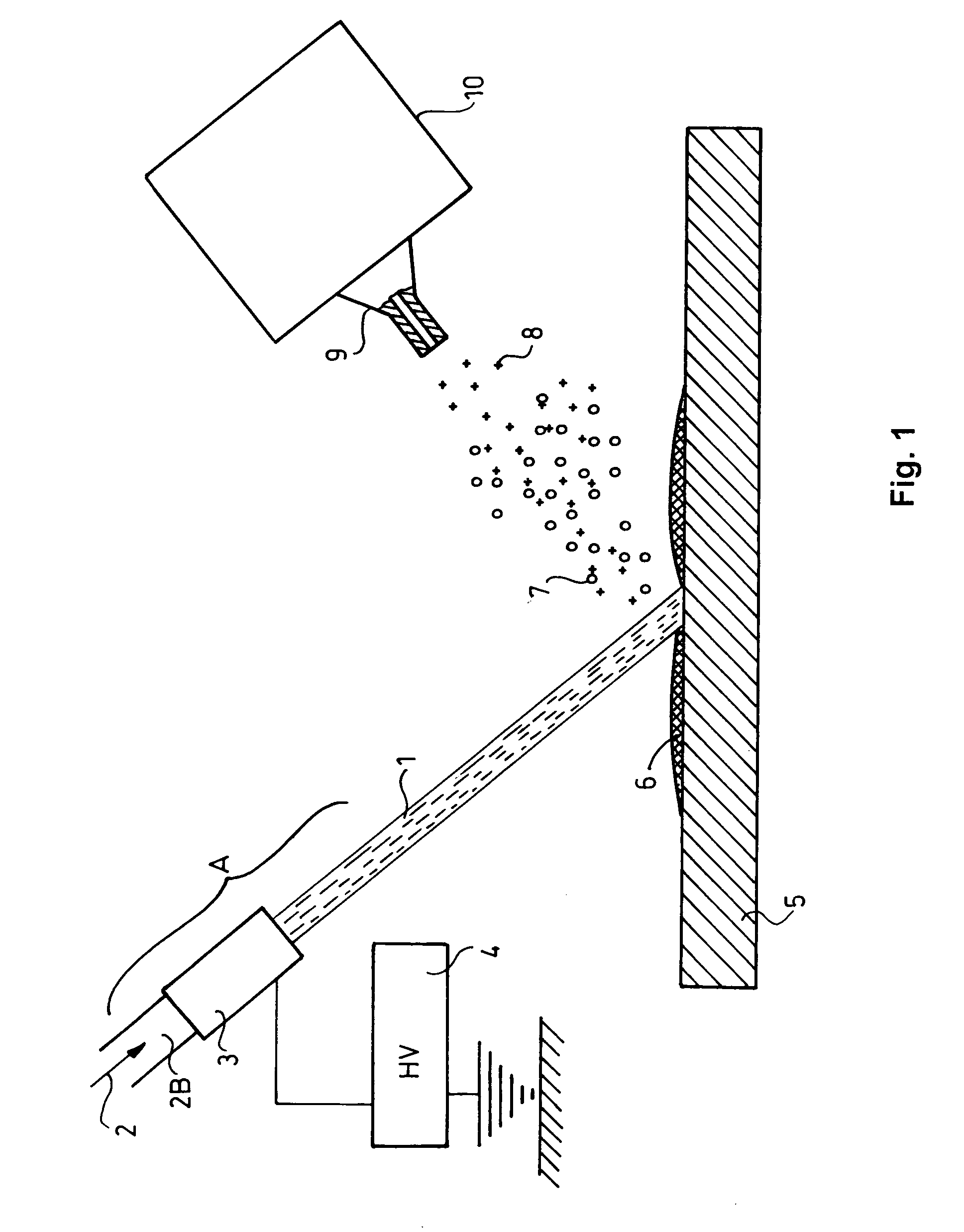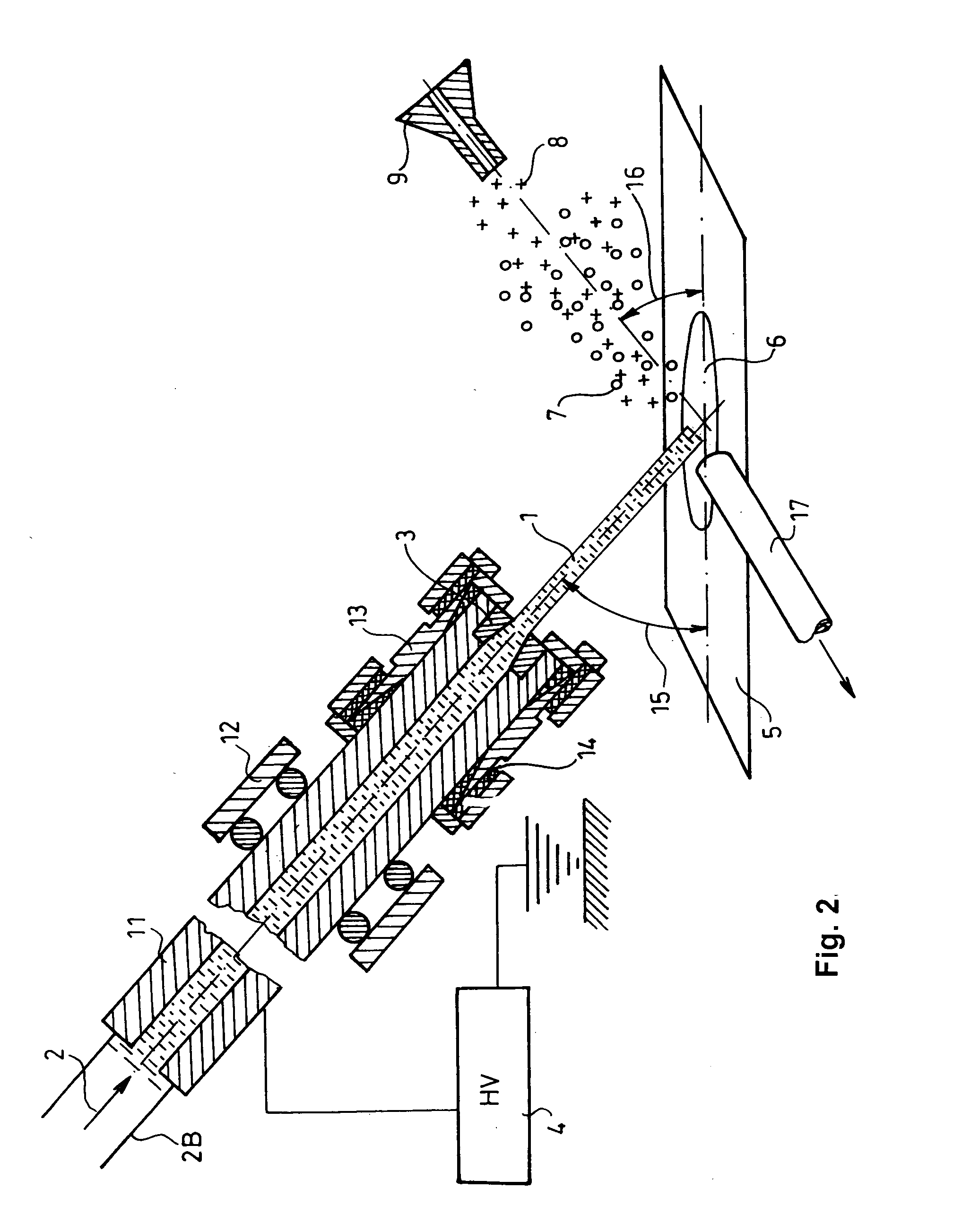Method and device for desorption ionization by liquid jet
a liquid jet and ionization technology, applied in the direction of mass spectrometry, separation processes, instruments, etc., can solve the problems of sample dissolved, limited molecular weight range of molecules, and inability to analyze non-volatile compounds
- Summary
- Abstract
- Description
- Claims
- Application Information
AI Technical Summary
Benefits of technology
Problems solved by technology
Method used
Image
Examples
example 1
Water Jet Desorption Ion Source for Mass Spectrometry to Analyze Dried Solvent Solution Droplets
[0122]1.1. The Water Jet Desorption Ion Source for Mass Spectrometry Comprises the Following Parts:[0123]HPLC pump (Jasco),[0124] 1 / 16″ OD, 1 mm ID stainless steel tube (11),[0125]connectors (Swagelok, Upchurch) (13),[0126]seals (Swagelok, Upchurch) (14),[0127]5 μm ID sapphire nozzle (3),[0128]2 moving stages for 3D linear moving (Newport),[0129]rotating stage for rotation in one dimension (Newport),[0130]high-voltage power supply (Bertan) (4)[0131]HDPE tube, 1 / 16″ OD, 1 mm ID (17),[0132]membrane pump,[0133]mass spectrometer (Thermo Finnigan LCQ Duo).
[0134]1.2. Construction of Water Jet Desorption Ion Source for Mass Spectrometry
[0135]Schematic drawing of apparatus is shown on FIG. 2. Stainless steel 11 tube is connected to HPLC pump through HDPE tube and 3 nozzle is connected according to FIG. 2. The end of stainless steel tube having the nozzle is mounted on rotating stage utilizing sui...
example 2
Water Jet Desorption Ion Source for Mass Spectrometry to Define Spatial Distribution of the Concentration of Specific Compounds in a Sample
[0141]2.1. Water Jet Desorption Ion Source for Mass Spectrometry to Define Spatial Distribution of Concentration of Specific Compounds in a Sample Comprises the Following Parts:[0142]HPLC pump (Jasco),[0143] 1 / 16″ outer diameter, 1 mm internal diameter stainless steel tube, which is sealed on one end by welding in a length of 0.2 mm, and the sealed section is drilled through by means of laser drilling to form a 1 μm diameter circular cross-section orifice (11),[0144]connectors (Swagelok, Upchurch) (13),[0145]seals (Swagelok, Upchurch) (14),[0146]2 computer controlled moving stages for 3D linear moving (Newport),[0147]rotating stage for rotation in one dimension (Newport),[0148]high voltage power supply (Bertan) (4),[0149]HDPE 17 tube, 1 / 16″ outer diameter, 1 mm internal diameter,[0150]membrane pump,[0151]mass spectrometer (Thermo Finnigan LCQ Duo...
example 3
Surgical Device Based on Water Jet Desorption
[0158]3.1. Surgical Device Based on Water Jet Desorption Comprises the Following Parts (the Device is Shown in FIG. 4):[0159]HPLC pump (Jasco),[0160] 1 / 16″ outer diameter, 1 mm internal diameter stainless steel tube (11),[0161]connectors (Swagelok, Upchurch) (13),[0162]seals (Swagelok, Upchurch) (14),[0163]pulled silica capillary nozzle having 1 to 5 μm internal diameter (3),[0164]high voltage power supply (Bertan) (4),[0165]HDPE tube, 1 / 16″ outer diameter, 1 mm internal diameter (17),[0166]membrane pump,[0167]mass spectrometer (Thermo Finnigan LCQ Duo).
[0168]3.2. Construction of Surgical Device Based on Jet Desorption
[0169]Fused silica capillary having 0.32 mm outer diameter and 10 μm internal diameter is pulled to 1 μm outer diameter at one end (3) and the other end of it is connected to HDPE tube having 1 / 16″ outer diameter which is connected to HPLC pump. Copper tube (20) having lengths of 1 m, ⅛″ outer diameter and 2 mm internal diam...
PUM
 Login to View More
Login to View More Abstract
Description
Claims
Application Information
 Login to View More
Login to View More - R&D
- Intellectual Property
- Life Sciences
- Materials
- Tech Scout
- Unparalleled Data Quality
- Higher Quality Content
- 60% Fewer Hallucinations
Browse by: Latest US Patents, China's latest patents, Technical Efficacy Thesaurus, Application Domain, Technology Topic, Popular Technical Reports.
© 2025 PatSnap. All rights reserved.Legal|Privacy policy|Modern Slavery Act Transparency Statement|Sitemap|About US| Contact US: help@patsnap.com



